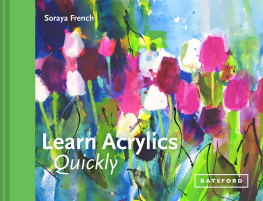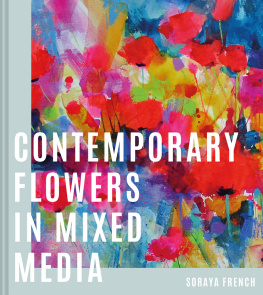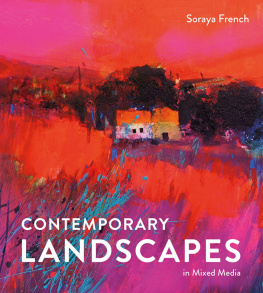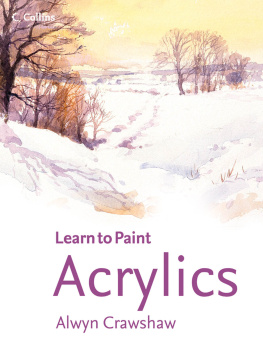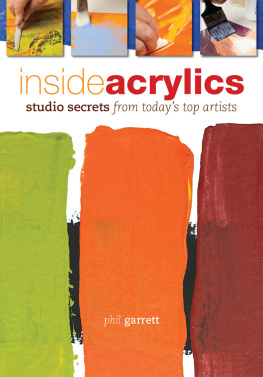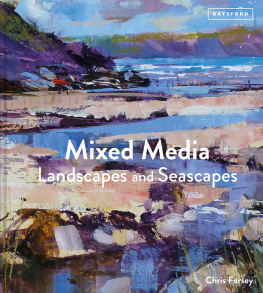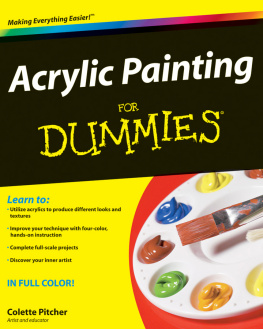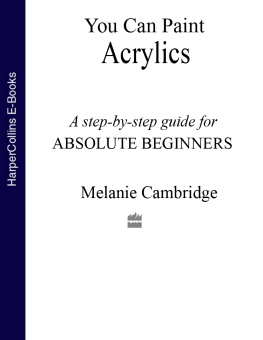Contents
Guide


Learn
Acrylics
Quickly
Soraya French

DEDICATION To my amazing trio Tim, Yasmin and Saasha, with all my love x
ACKNOWLEDGEMENTS I would like to thank Tina Persaud and Cathy Gosling for commissioning this book and believing in me, and Nicola Newman and Diana Vowles for their sympathetic editing. This is a great opportunity to send my thanks and gratitude to my Golden family across the pond for their support and generosity and for making the best quality artists materials, which are a dream to work with. To St Cuthberts Mill for all the years of sponsoring me with their amazing and wonderful papers. To Jason and Sandy Mackie at Global Art Supplies for their continued support with the Golden Working Artist program and endless supply of materials. To Rosemary and Symi of Rosemary and Co for making the best brushes in the world.
Contents

: Searching for Crabs 5645cm (2218in)
Detail of abstract image.

Summer Meadow
Inks and heavy body acrylics on watercolour paper 5645cm (2218in)
Introduction
Acrylic paint requires no specific set of rules, so it offers artists of all levels the freedom to progress with their painting in a relaxed and enjoyable manner. The ability to correct mistakes makes it ideal for beginners, while it enables the experienced artist to push the boundaries like no other medium.
It is also by far the most versatile medium, as it can mimic watercolours in its liquid form, while in thicker consistencies it can be applied with techniques similar to those used for oil paint. However, it has characteristics that neither oils nor watercolour possess. As it dries quickly, multiple layers can be applied in quick succession and great results can be achieved in one painting session but for those who dont appreciate the quick-drying nature of acrylics, there are colours with extended open time.
I am delighted to be able to share my passion for this wonderful medium with you and hope that the information in this book will help you get to grips with painting in acrylics in a relatively short space of time.

Choosing your acrylic paints
My policy has always been to buy fewer colours but to go for the best-quality paints available. With water-based media such as acrylics you can mix an infinite number of secondaries, tertiaries, darks and neutrals with quite a limited palette that consists only of a warm and a cool version of each primary colour red, yellow and blue plus Titanium White for mixing tints with covering power. The brand you buy may depend on your budget, but in the long run it is more economical to use good-quality paints. If you opt for student-grade colours, invest in a reputable brand. Alternatively, mix top-quality paints with a soft gel to extend the colours and make working with them more economical.
Paints come in jars and tubes in a few different sizes and it is a matter of personal preference which one you choose. On you will find a suggested basic palette.

Different types of acrylic colours
Acrylic colours come in a range of consistencies and containers.

Lilies and Anemones
This small vignette of lilies and anemones is a mixture of inks and fluid colours with a few touches of heavy body paint in a loose and free style.
Surfaces
You can paint with acrylics on a wide variety of surfaces, including acrylic and watercolour paper, canvas, panel, aluminium, mount board and more. Each affects the look and feel of the end result. The only two surfaces to avoid are shiny and greasy ones, which could result in the paints peeling later.
In general your support needs to have a certain amount of grip for acrylic paints to adhere to. Priming is optional, but you will find that the surface of raw canvas and panel becomes much nicer when primed with either gesso or acrylic medium. You will achieve a different and surprisingly interesting result with inks on primed paper or canvas. When painting on a surface such as MDF it is best to prime it to avoid the possibility of chemicals seeping into the painted surface. Experiment with a few surfaces to find what works for you.
Work on canvas and board may be framed without glass, but its advisable to apply two coats of varnish either a polymer varnish to brush on or an archival spray varnish. Both are available in matte, gloss and satin finish.

1 Bockingford NOT watercolour paper 2 Saunders Waterford NOT watercolour paper 3 Textured mount board 4 Saunders Waterford HP watercolour paper 5 Smooth mount board 6 Saunders Waterford High White 7 MDF board with tinted gesso 8 Canvas 9 Plywood panel.

Snowdrops
Heavy body acrylics on canvas 2020cm (8 8in)

Snowdrops
Inks and heavy body acrylics on watercolour paper 2023cm (89in)
Brushes
A set of good-quality brushes will really help you to achieve beautiful brushstrokes. For inks you need the softness of watercolour brushes, which you can load with plenty of pigment and water to help the free flow of the ink from your brush to the surface. Conversely, heavy body colours call for the stiffness of acrylic brushes that can cope with the heavier texture of the paint. Both types are suitable for fluids or soft body colours.
The eventual shapes of your brushes will depend on the style you develop. However, there are some standard shapes that are useful to have at the outset.
Flat brushes leave definite square-ended marks and dont allow you to go into too much detail.
Round brushes are useful for rounder deposits of colour and, depending on their size, for smaller details. Some artists prefer to use round brushes for washes of ink.

